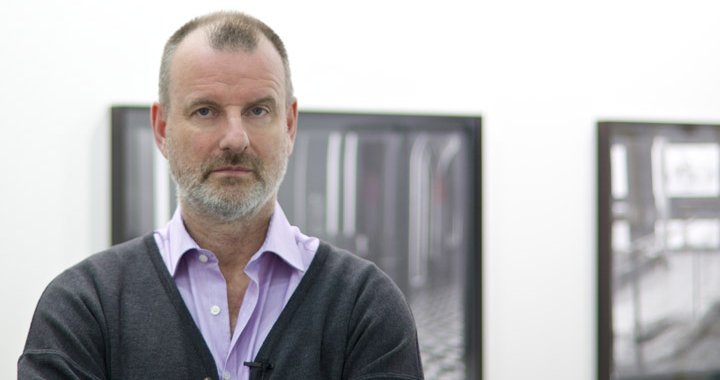
At the end, the artwork survives
An interview with German gallerist Volker Diehl
12/08/2016
I met Volker Diehl during his visit to Latvia – he had arrived to attend the opening of the “Elective Affinities” exhibition that is still taking place at the Latvian National Museum of Art’s Arsenāls Exhibition Hall. The show, dedicated to German art from the 1960s to the present, features several works from DIEHL Gallery in Berlin.
Today Volker Diehl has two gallery spaces in Berlin – DIEHL Gallery in Charlottenburg, and DiehlCUBE in Wilmersdorf – a 7x7x7-metre-large vitrine and laboratory of alchemical presences containing messages, statements, and context-based topics of immediate art. DIEHL Gallery focuses on contemporary art with international relevance – for instance, the programme includes the internationally acclaimed Chinese-born artist Zhang Huan (New York), the renowned Spanish sculptor Jaume Plensa (Barcelona), and the Russian Blue Noses group and Olga Chernysheva (Moscow). Alongside these international positions, the programme is ultimately balanced and rooted by German artists.
We met to talk in Jūrmala, where Volker Diehl was staying at his friend’s house, and spoke about the reasons why he became interested in art, how he sees the contemporary art world today, and what led him to Russia (Volker Diehl lived in Moscow for six years; in 2008 he was the first Western gallerist to open a gallery space in Moscow). The gallerist also revealed his thoughts on the Latvian contemporary art scene and the reasons why it is not known internationally.
_%201995_%20colour%20c-print_%20101_6%20x%20152_4%20cm_%20Ed.%204_15.jpg)
Zhang Huan, Nine Holes (L), 1995, colour c-print, 101,6 x 152,4 cm, Ed. 4 of 15. Photo: DIEHL gallery
When did you first start thinking about art?
I never did anything else in my life. I grew up in a small village – not far from Dortmund. I always wanted to be connected to art and to music. As a young man, I played the contrabass in a symphony orchestra for a while, but art was always my passion and I never wanted to do anything else. I wanted to be an artist, so I studied sculpture for one year in Münster, but it didn’t take long for me to understand that it wasn’t the right thing for me – I didn’t like to work alone in the studio, I like communicating with people. After one year there, I switched to art history studies, in Berlin. During these studies I was already working professionally. I started to work for a gallery – DAAD (German Academic Exchange Service), where I put together all kinds of exhibitions, for I was the assistant to the main curator. At that time I met a lot of really wonderful artists – André Thomkins, Markus Raetz, Wolf Vostell, Dieter Hacker, Shigeko Kubota, Emmett Williams, his wife Ann Nöel, a lot of Fluxus artists. I also worked for Shigeko Kubota – the wife of Nam June Paik – for one year. Through her I met Nam June Paik, as well as Takehisa Kosugi, with whom I went to Paris to assist with his concerts.
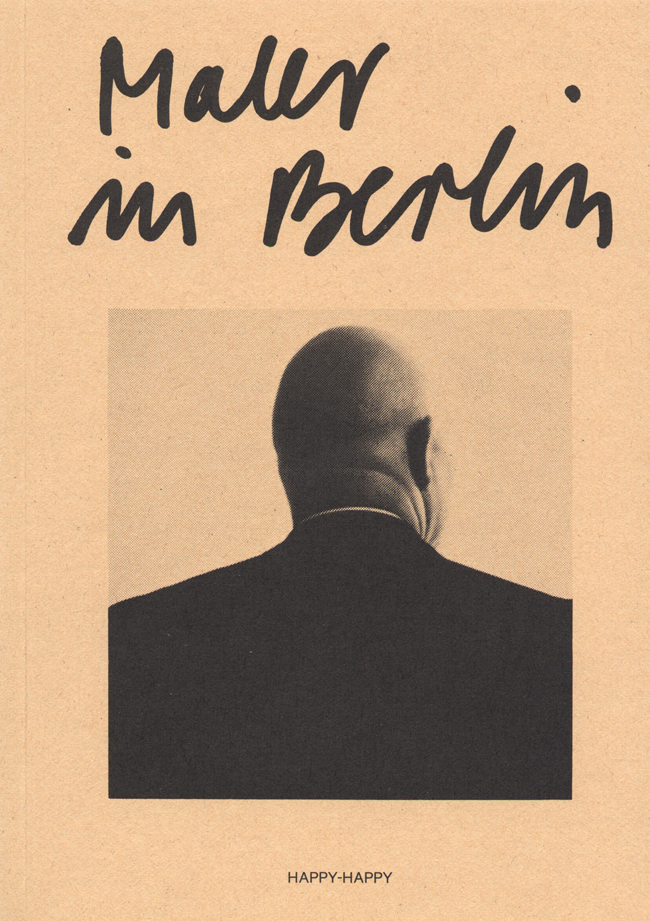
“Berliner Maler” by Volker Diehl and Roland Hagenberg. 1982, Published by HAPPY-HAPPY, Berlin
Through DAAD I met the independent curator Christos Joachimedes, as well as Norman Rosenthal – exhibitions secretary at the Royal Academy in London. Both of them were planning an exhibition called “Zeitgeist”, for which they were looking for an assistant. So, I became their personal assistant for a year and a half. Today people would say “co-curator”, because we were such a small team.
It was a huge exhibition – 45 artists, and all the big names of that time were in it: Joseph Beuys, Andy Warhol, Mario Merz, Anselm Kiefer, Francesco Clemente and Georg Baselitz, Janis Kounellis, Cy Twombly, Sigmar Polke etc. It was a very important exhibition and it really boosted my hunger of arts and life. I met all these wonderful artists in their studios, and helped with realizing commissions for the Zeitgeist exhibition. Parrallel I even published a book, “Maler in Berlin”, together with Roland Hagenberg, with artist interviews and photos.
After that, it was clear that I would never do anything else but work in the art world.
When did you open Volker Diehl Gallery?
The gallerist Folker Skulima offered me a junior partnership after the “Zeitgeist” show, so in 1984 I started to organize young contemporary artists’ exhibitions in the gallery. I did shows with Jaume Plensa, Leiko Ikemura, Erwin Bohatsch, Rosemarie Trockel, Gianni Dessi, and Pizzi Canella, among many others.
In 1990 I took over the gallery, and since then it has had my name. Besides the gallery, I have done a lot of other projects since then – in 1996 I was one of the founders of Art Forum Berlin (and its managing director for 2–3 years). I was travelling a lot to Moscow because, at the time, I thought that in the near future it would be a new hot-spot for contemporary art (many people thought so back then). So, in 2005 the biennale was founded in Moscow; two years later – The Garage. Many foundations (like the Ekaterina Cultural Foundation, etc.) and collectors started to open private museums and foundations – like Igor Markin and Stella Kay. I thought it was a good time to open a gallery in Moscow, and I did – in April 2008 I opened the gallery with Jenny Holzer’s solo show. But then in September, when I opened Wim Delvoye, everything was already over – the financial crisis had started, and nobody was buying art anymore. That was a crazy week. Monday Damian Hirst and Sothebys and the Lehman Brothers Bankruptcy, Tuesday the opening of Garage with a Kabakov exhibition, Wednesday Popup show of Larry Gagosian and Thursday Wim Delvoye in my gallery. I did a few more shows after that in Moscow, like Zhang Huan and Jaume Plensa. And the last show was with Olga Chernysheva. I ended up having to close the gallery at the end of 2009.
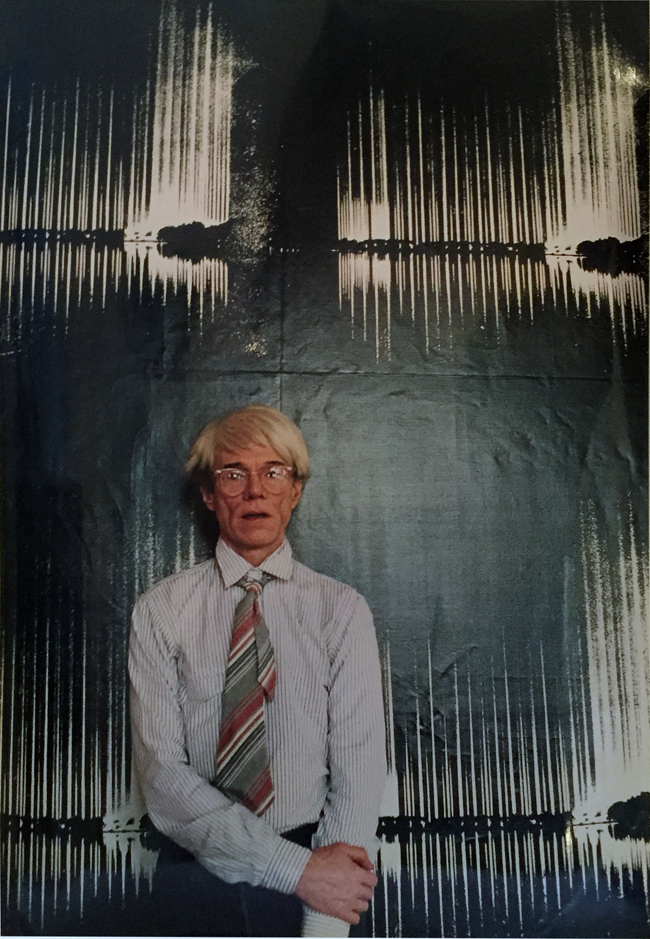
Andy Warhol in front of his first paintings of Speer’s Light Dome. Photo from personal archive
Going back to the “Zeitgeist” period – in an interview, you said that meeting with Joseph Beuys changed your perspective on how to look at art.
Joseph Beuys was a very charismatic person. I got to know him more when he was working on his installation “Blitzschlag” in Martin-Gropius-Bau, for the “Zeitgeist” exhibition. I liked his politeness and generosity. His words were like statements. It left quite an impression on me, watching a man with such vision. I could easily understand why he was so influential and had so many admirers. I really appreciated it at that time, and I still have a photo of us both in my gallery office.
I had an equally impressive encounter with Andy Warhol. He came to Berlin in March of 1982. At a meeting, he asked me if I could get him photos of Albert Speer’s architecture from the 1930s. I found a lot of photos in the archives, which we then sent to him.
He used one of the photos which I had found in the Landesarchiv [the State archive] – it was a photo of the Light Dome [Cathedral of Light – red.], which Albert Speer designed in 1934, in Nuremberg.
Speer had used anti-aircraft searchlights, aimed skyward, to create the columns of light. Inspired by this photo, Warhol did a whole series of paintings; he sent me a photo where he is standing in front of one of his first paintings of Speer’s Light Dome.
Later, in May 1983, I visited him in New York, at The Factory.
When he entered the room, he had everybody’s attention – without even doing anything, just by being there. I will never forget that.
It was a really wonderful gift, and I’m very thankful that I had the chance to meet these artists.
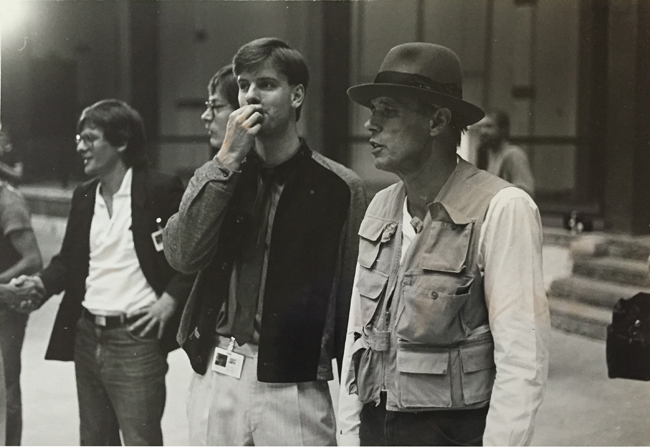
Volker Diehl and Joseph Beuys, 1980s. Photo from personal archive
Could you explain how you select artists for your gallery?
When I started, it was a small art world, and it was very different – romantic even – compared to today. At that time we were looking for an artist who could make a new and innovative statement – something that would be unique. And it was much easier to select and to work with artists because back then, all of the galleries were working pretty much on the same financial level. Nowadays it’s a very different business. Today, you don’t have such a broad choice of artists; you have to find your niche, one where you will be able to represent an artist.
The expectation to do art fairs has become increasingly stronger. Fewer collectors are visiting galleries, although that is the place where everything starts once the artworks leave the studio; consequently, artists want to be shown in art fairs, which creates a lot of pressure on the gallerist because fairs are becoming increasingly expensive to attend.
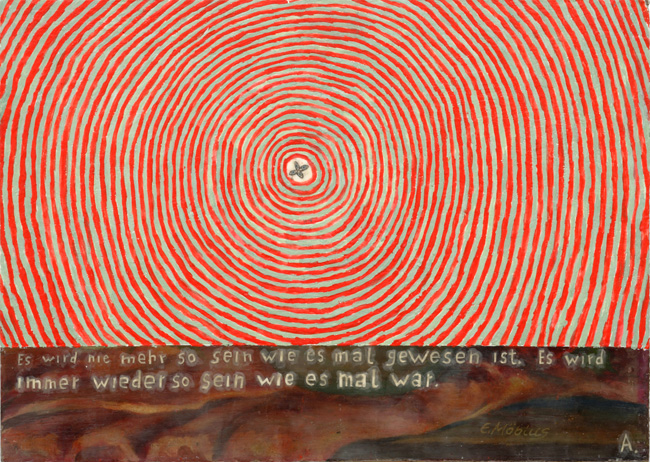
Martin Assig, Vergangenheit, 2007, encaustic on wood, 50 x 70 cm. Photo: DIEHL gallery
There are some artists which I have been representing for 27 years now – Martin Assig, for instance. He was never a hyped superstar artist; he is a serious artist. From the beginning, his works were being picked up by very good collections, and he did a lot of museum shows all over Europe. He is a much more quiet artist, and a more sophisticated personality, than this new generation of “loud and glamorous event”-type artists.
I think that in the last 10–15 years, the world has been divided into two parts: We’re used to saying that there is “serious music”, and then there is “entertainment music”; that was never the case in the [visual] arts. But now we can say that we have “serious art”, and we have “entertainment art” – the latter being loud and, in a way, even aggressive. Sometimes it can be a problem for artists who are quiet, intellectual, and more sensitive – they need to exert more effort to get attention. I’m more into this kind of an art world.
%2011_%202008%20-%2010_%20c-print%20diasec_%20223%20x%20168%20cm_%20Ed.%201_6.jpg)
Thomas Florschuetz, Enclosure (nm) 11, 2008–10, c-print diasec, 223 x 168 cm, Ed. 1 of 6. Photo: DIEHL gallery
Is it more difficult to sell this kind of art?
It is, but one way [to succeed] is to always stay ahead, so that you can survive even in difficult times. I have some good friends amongst the blockbuster galleries, and I admire how they do it. I’m not the kind of person who can do that, though. They have galleries in Berlin, London, New York, Los Angeles, Hongkong, all over the world now, with 50, 100 or more people working for them. I tried once in Moscow; I failed, and it was a good lesson that taught me that I’m just not like that; I can’t do it. I try to be myself and to stay authentic. I have a much smaller gallery now; I have much less people working for me, and I don’t like to do art fairs (with few exceptions), even though I have founded two art fairs myself together with partners – Art Forum Berlin in 1996, and Cosmoscow in 2010.
One exception where I exhibit is the Vienna Contemporary art fair because it is focused on Eastern Europe and Russia. But generally speaking, I’m happier without fairs.
I try to be straight and honest with myself, and also with my work and gallery programme.
In our world, lots of people are running after something without realising it. Running after a projection, which is very dangerous – artists are running after something that they call “fame”, and gallerists are very often running after what they call “success”. It is very often a falsification – a kind of Fata Morgana – you see something that isn’t really there.
What about Russian art – how did it become an interest of yours?
Russian art was always something that interested me. It actually started more with literature and music. I was living in Berlin during Perestroika, and there was something about Perestroika, Glasnost and Gorbachev in the news every day; it was also being widely discussed in society. As a positively-thinking person, I became more and more interested; I believed in Gorbachev’s visions, and I thought, too, that our future would be a better world.
Along with Perestroika and Glasnost, the first artists came to the West. One was Sergey Volkov, who was invited by a collector in Berlin. I saw his works, I loved them, and I did my first exhibition with his paintings before the Wall came down in the spring of 1989. Six months later, the world was different; I took it a little bit as an omen.
At that time I also met the first Russians – like Aidan Salakhova, with whom I became very close friends. I personally admire her a lot. She brought me to Moscow in the mid 1990s, and I simply became very interested in the country and the city [chuckles] – in its artists, in its galleries, what was going on, etc. I did several more exhibitions in Berlin in the 90s – such as with Blue Noses, Alexey Kalima, Erbossyn Meldibekov from Kazakhstan, then Olga Chernysheva, Sergey Bratkov, and the young artist Ivan Gorshkov. I think Russia always had good art, but they didn’t have the necessary infrastructure.
_%202013_%20charcoal%20on%20paper_%2041_5%20x%2059%20cm.jpg)
Olga Chernysheva, Untitled (White Cable), 2013, charcoal on paper, 41,5 x 59 cm. Photo: DIEHL gallery
I remember that there was a period during which all of the big Russian art stars were showing all over the world – artists like Kulik, Mamishev-Monroe, Dubosarsky & Vinogradov...
But it was always a difficult business, I think. Most of those artists don’t have strong representations in the West; there are a few exceptions, like Olga Chernisheva, who has one museum show after another: she was in the Biennale di Venezia last year, she is in Manifesta now, she’ll be at The Drawing Center, in New York, in October. Sure, you can see the older masters – like Kabakov, Bulatov, also Pepperstein – in Western galleries, but Russia is the largest country in the world, so in comparison, the art scene there is tiny.
So, in your opinion, a successful artist is one who is represented by a good gallery in the West.
Like it or not, you need a kind of infrastructure around you if you want to be successful – whatever “successful” means. I don’t mean money, but having visibility in galleries and museums – that’s what an artists needs. And here in the West, the art world is perfectly organised on all levels. Not only in terms of galleries and museums, but also with such things as curators, foundations, collections, art magazines, art fairs, etc., etc...
_%202008_%20painted%20steel_%2060%20x%2048%20x%2048%20cm.jpg)
Jaume Plensa, WE (Nomad 8 alphabets), 2008, painted steel, 60 x 48 x 48 cm. Photo: DIEHL gallery
Nowadays there are more and more art consultants emerging onto the scene, and most of them advise their clients to view art as a financial investment. What do you think about this?
It is very easy to call yourself an adviser. Anybody can do that after visiting a few art fairs, and a lot of people also call themselves curators [laughs]. When we started in the 80s, it was not very sexy to be a gallerist. People would smile and ask you what you do for a living. But with all of the money involved in the art world today, there is more opportunity for speculation and investment, and it has become very attractive to a lot of people, not just serious art collectors.
There is a completely new generation of advisers and consultants out there now.
Where do you think this will take us?
I don’t know. Good question! If I knew, I could sell that information for a lot of money [laughs]. No, but seriously, I’m sure that like with everything in our world, you have ups and you have downs. For some years now, the art world has been driven by economics. And the more money there is in the market, the more bad art moves into the market. I think that’s even more dangerous than the speculation aspect because bad art always shows its true face sooner or later, and that will hurt the market much more than any speculation. There is a lot of art which gets produced just because of the market, not because the artist wants to do the art. The gallery calls the artist and says – I’m doing this art fair, I need that kind of artwork. So the artist starts to produce a projection of something – something which he never would have done if there hadn’t been this pressure of the market and the art fairs. I like it when artists say “no”, and when artists create works because they just feel the need to do them, not because the works will make them another 100 000 dollars... At the end, every artist still has the right, and every gallerist still has the possibility, to say “no” to speculation. But there is a lot of opportunism in the world; people are weak, they don’t say “no”.
How can one say what is bad art, and what is not? What are your criteria?
It will become clear in time – what is good, and what is not. For now, we have to deal with it.
When you do something as a favour, or if you do it just for the money – I think that is a very weak position, one that creates something which has a kind of dishonesty around it.
I try to work with people who are outside of this circus. There is always wonderful art you can find. It depends on you, on me, on every single person – you just have to work for it, believe in it. Don’t run after something that has the so-called “hype”. Most of the time, it doesn’t last very long.
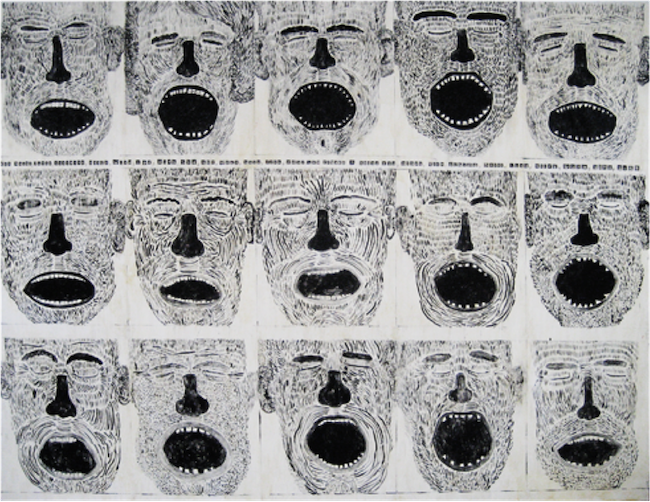
Martin Assig, Die Nacht, 2010, encaustic and tempera on wood, 200 x 260 cm. Photo: DIEHL gallery
Recently we had a discussion and an article in our online magazine about the Baltic art situation in the art world – why we are relatively unknown internationally. There are some artists who work with galleries in Western Europe, but they are few. For example, it is different with Russian art – people who are interested in art know about Russian art.
Yes, but how many people live in Latvia? It is a very small country. Even if you put all three Baltic States together, you really don’t have many galleries.
Read in the Archive: Why Is Baltic Art So Little Represented On The International Scene?
Do you think this is the main reason behind our invisibility?
… it’s one of the reasons. You need more galleries, you need more collectors, more small institutions, curators, etc. – a working infrastructure.
In Germany we have the system of Kunstverein [art associations – ed.], a 200-year-old model. Every city has a Kunstverein supported by members. They do very important work – organize solo shows of young artists, support interesting exhibitions along with galleries and museums. This is only one example, but you need a system with many mosaic parts. Something like that does not exist here.
I would say there are several exhibition openings every week in Riga. Some bigger, some smaller, but there are exhibitions.
But we don’t know about them. [Laughs] I didn’t know that. Is it good art?
All sorts of art.
But all sorts of art is not enough. You have to be a little more selective. I don’t know many Latvian artists.
I saw the exhibition of [Miervaldis] Polis. I think he has some interesting aspects in his work. I met him in Berlin in the early 90s.
I saw Jānis Avotiņš – I liked his works. I already knew of him because he shows with some Western galleries. The other artist I liked was Paulis Liepa. Jānis Zuzāns showed me his paintings.
This country has a lot of potential. You have a few good collectors already. And I personally like these places that are a little bit “unfinished” – where you have the feeling that people need your expertise and your knowledge. Nobody needs me in New York, but when I come to Riga or Moscow, I always have the feeling there’s something to be done. That’s the interesting part. You can create something.
If you have good artists, then they can change the world in a very short time. If you don’t have really good art, you can do whatever you want with your gallery, magazine, museum – but it won’t succeed. Sometimes you need one good artist who can change the art scene. The English art world was dead in the 1980s, but then the Young British Artists came along. Like it or not, but they did something very interesting and very strong, and they changed the whole art world in England in just a few years.
We should keep that in mind.
People will always judge the artwork, which lasts longer then the person who created it.
That is the power of art.
That would be a good title – At the end, the artwork survives.
Maybe people will say I’m too romantic, but I don’t think so. I think it is the truth. We have seen so many falsifications in art history. There were artists who were super famous in their time – like Hans Makart in Vienna, or Franz von Lenbach in Munich in the 19th century. When there is a lot of money involved, you always have this masquerade. What Makart did is, he had masquerade wagons with costumes driving through the city; he was like a king in those days. And now very few people even know his name.
There are always artists who celebrate themselves, making a lot of money and thinking they are the centre of the world. And then there are artists who are hiding away with a little drawing somewhere – and in the end, that little hidden drawing turns out to be the strongest one of all, the most powerful work. Somehow, I believe in that.